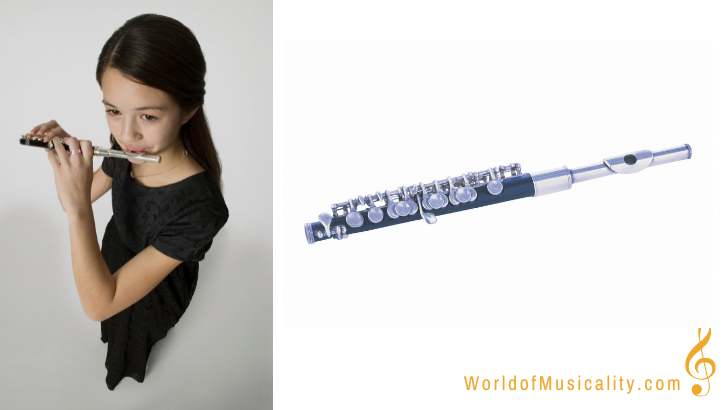
The piccolo is the smallest and highest-pitched member of the flute family, known for its bright, piercing tone.
It features a cylindrical body, usually made of metal or wood, and is half the size of a standard concert flute.
The piccolo is commonly used in orchestras, military bands, and solo performances, adding brilliance and sparkle to musical ensembles.
Detailed Instrument Description
| Instrument Name | Piccolo |
| Instrument Family | Woodwind |
| Alternative Names | The piccolo is often simply called “piccolo” in various languages, though it is also referred to as “flauto piccolo” (Italian), “petite flûte” (French), and “kleine Flöte” (German). |
| Geographical Presence | The piccolo is played worldwide, being an essential part of Western classical music traditions. It is a staple in symphony orchestras, wind ensembles, military bands, and solo performances across Europe, the Americas, Asia, and beyond. |
| Instrument Classification | The piccolo falls under the Hornbostel-Sachs classification system as 421.121.12, identifying it as an edge-blown aerophone. This system classifies musical instruments based on how they produce sound, with the piccolo classified as an aerophone where sound is produced by a vibrating column of air. |
| Unique Features | The piccolo is known for its small size and high pitch, typically an octave above the concert flute. It has a narrower bore and shorter body, which contribute to its bright and piercing sound. The piccolo’s ability to project over an entire orchestra makes it a distinctive and vital instrument in ensemble settings. |
| Sound Characteristics | The piccolo produces a bright, piercing, and penetrating sound. Its tone is more shrill and less mellow than the concert flute, making it ideal for adding sparkle and brilliance to the upper register of orchestral and band music. It can produce both soft, delicate tones and loud, powerful notes. |
| Typical Music Genres | The piccolo is primarily used in classical music, including orchestral, band, and solo repertoire. It is also found in military music, marching bands, and occasionally in contemporary and popular music, providing a unique tonal color. |
| Components | Headjoint, Body, Keys, Lip Plate, Embouchure Hole |
| Construction | The piccolo is traditionally made of wood, such as grenadilla or ebony, though many modern piccolos are made of metal or a combination of materials. The body consists of a headjoint and a cylindrical body with keys typically made of metal and covered with pads to create an airtight seal over the holes. |
| Size and Weight | The size of the piccolo typically ranges from 30 to 32 centimeters (12 to 13 inches) in length. The weight varies between 100 to 150 grams (0.2 to 0.3 pounds), depending on the materials used. |
| Variations and Customizations | Variations of the piccolo include different materials, key configurations, and headjoint options. Customizations might include engraved or inlaid designs, different types of headjoints for varied sound quality, and ergonomic key adjustments. |
| Instrument History | The piccolo’s history dates back to the early 18th century, evolving from the flauto piccolo used in Baroque music. It gained prominence in the 19th century with the expansion of the orchestral and military band repertoire. Composers like Beethoven and Sousa significantly expanded the piccolo’s use in their works. |
| Similar Types of Harp | Concert Flute, Alto Flute, Fife |
| Playing Technique | The flutist blows across the embouchure hole to produce sound, using their fingers to press the keys and cover the holes to change pitches. Proper breath control, finger technique, and embouchure are essential for producing a clear and controlled sound. Techniques such as vibrato, trills, and flutter-tonguing add expression to the music. |
| Notable Composers | Ludwig van Beethoven, John Philip Sousa, Igor Stravinsky |
| Famous Works | Beethoven’s “Symphony No. 9,” Sousa’s “Stars and Stripes Forever,” Stravinsky’s “The Firebird” |
| Maintenance | Regular maintenance includes cleaning the instrument after playing, oiling the key mechanisms, and occasionally replacing pads and corks. The piccolo should be stored in a case to protect it from damage and environmental changes. |
| Learning Difficulty | Moderate to high; requires coordination and dexterity to manage breath control, finger positions, and embouchure. Learning proper hand techniques, breath support, and music reading are essential for effective playing. |
| Prominent Players | Jean-Pierre Rampal, Trevor Wye, Nicola Mazzanti |
| Notable Performances | Notable performances include concerts by prominent piccolo players at major venues and festivals worldwide, such as the BBC Proms and the National Flute Association Convention. |
| Famous Orchestras/Bands | Prominent ensembles featuring the piccolo include the Berlin Philharmonic, the New York Philharmonic, and the United States Marine Band. |
| Price Range | Piccolos range from $500 to $5,000 or more, depending on the craftsmanship, materials, and features. Beginner models start around $500, while professional models with custom features can exceed $5,000. |
| Interesting Facts | 1. The piccolo is the highest-pitched instrument in the woodwind family. 2. It is often used to represent birdsong and other high, bright sounds in orchestral music. 3. The piccolo’s small size makes it highly portable, often used in military and marching bands. 4. Some piccolos have a split-E mechanism to facilitate easier fingering of high E notes. 5. Despite its small size, the piccolo has a powerful sound that can cut through an entire orchestra. |
If you would like to learn more facts about the amazing world of musical instruments, visit our homepage at worldofmusiclality.com or click the links below to explore the rest of our site.







